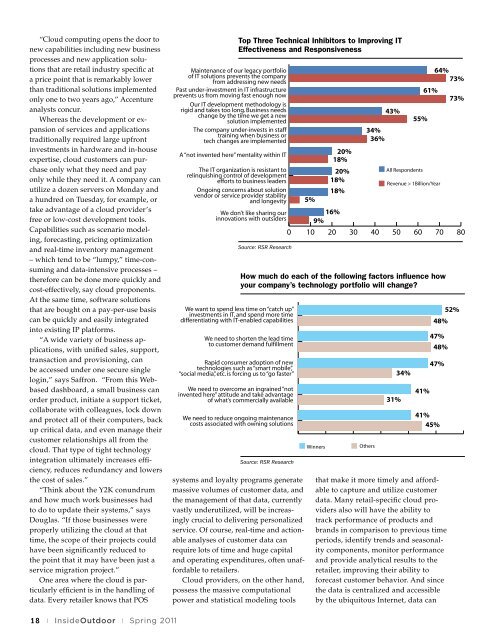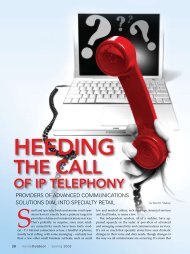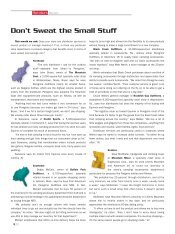CLOUD COMPUTING AND THE FUTURE OF RETAIL
CLOUD COMPUTING AND THE FUTURE OF RETAIL
CLOUD COMPUTING AND THE FUTURE OF RETAIL
Create successful ePaper yourself
Turn your PDF publications into a flip-book with our unique Google optimized e-Paper software.
“Cloud computing opens the door to<br />
new capabilities including new business<br />
processes and new application solutions<br />
that are retail industry specific at<br />
a price point that is remarkably lower<br />
than traditional solutions implemented<br />
only one to two years ago,” Accenture<br />
analysts concur.<br />
Whereas the development or expansion<br />
of services and applications<br />
traditionally required large upfront<br />
investments in hardware and in-house<br />
expertise, cloud customers can purchase<br />
only what they need and pay<br />
only while they need it. A company can<br />
utilize a dozen servers on Monday and<br />
a hundred on Tuesday, for example, or<br />
take advantage of a cloud provider’s<br />
free or low-cost development tools.<br />
Capabilities such as scenario modeling,<br />
forecasting, pricing optimization<br />
and real-time inventory management<br />
– which tend to be “lumpy,” time-consuming<br />
and data-intensive processes –<br />
therefore can be done more quickly and<br />
cost-effectively, say cloud proponents.<br />
At the same time, software solutions<br />
that are bought on a pay-per-use basis<br />
can be quickly and easily integrated<br />
into existing IP platforms.<br />
“A wide variety of business applications,<br />
with unified sales, support,<br />
transaction and provisioning, can<br />
be accessed under one secure single<br />
login,” says Saffron. “From this Webbased<br />
dashboard, a small business can<br />
order product, initiate a support ticket,<br />
collaborate with colleagues, lock down<br />
and protect all of their computers, back<br />
up critical data, and even manage their<br />
customer relationships all from the<br />
cloud. That type of tight technology<br />
integration ultimately increases efficiency,<br />
reduces redundancy and lowers<br />
the cost of sales.”<br />
“Think about the Y2K conundrum<br />
and how much work businesses had<br />
to do to update their systems,” says<br />
Douglas. “If those businesses were<br />
properly utilizing the cloud at that<br />
time, the scope of their projects could<br />
have been significantly reduced to<br />
the point that it may have been just a<br />
service migration project.”<br />
One area where the cloud is particularly<br />
efficient is in the handling of<br />
data. Every retailer knows that POS<br />
Maintenance of our Top legacy Three portfolio Technical Inhibitors to Improving IT<br />
64%<br />
of IT solutions prevents the company<br />
from addressing Effectiveness new needsand Responsiveness<br />
73%<br />
Past under-investment in IT infrastructure<br />
61%<br />
prevents us from moving fast enough now<br />
Maintenance of our legacy portfolio<br />
64% 73%<br />
of Our IT solutions IT development prevents methodology the companyis<br />
rigid and takes from too addressing long. Business new needs needs<br />
43%<br />
73%<br />
change by the time we get a new<br />
Past under-investment solution in IT infrastructure<br />
implemented<br />
55% 61%<br />
prevents us from moving fast enough now<br />
The company under-invests in staff<br />
34%<br />
73%<br />
Our IT development training when methodology business is or<br />
rigid and tech takes changes too long. are Business implemented needs<br />
36%<br />
43%<br />
change by the time we get a new<br />
solution implemented<br />
55%<br />
A “not invented here” mentality within IT<br />
20%<br />
The company under-invests in staff<br />
18% 34%<br />
training when business or<br />
The tech IT changes organization are implemented<br />
is resistant to<br />
20% 36% All Respondents<br />
relinquishing control of development<br />
efforts to business leaders<br />
18%<br />
A “not invented here” mentality within IT<br />
20%<br />
Revenue > 1Billion/Year<br />
Ongoing concerns about solution<br />
18%<br />
vendor or service provider stability<br />
The IT organization is and resistant longevity to 5% 20%<br />
All Respondents<br />
relinquishing control of development<br />
efforts We don’t to business like sharing leaders our<br />
16% 18%<br />
Revenue > 1Billion/Year<br />
Ongoing innovations concerns about with outsiders solution 9% 18%<br />
vendor or service provider stability<br />
and longevity 0 5% 10 20 30 40 50 60 70 80<br />
We don’t like sharing our<br />
16%<br />
innovations Source: with RSR outsiders Research<br />
9%<br />
0 10 20 30 40 50 60 70 80<br />
Source: RSR Research<br />
We want to spend less How time much on “catch do up” each of the following factors influence how 52%<br />
investments in IT, and your spend company’s more time technology portfolio will change?<br />
differentiating with IT-enabled capabilities<br />
48%<br />
We want We to need spend to less shorten time on the “catch lead time up”<br />
investments to customer in IT, and demand spend more fulfillment time<br />
differentiating with IT-enabled capabilities<br />
Rapid consumer adoption of new<br />
technologies We need to such shorten as “smart the lead mobile”, time<br />
“social media”, to customer etc. is forcing demand us to fulfillment “go faster”<br />
We need to overcome an ingrained “not<br />
invented Rapid here” attitude consumer and adoption take advantage of new<br />
technologies of what’s such commercially as “smart available mobile”,<br />
“social media”, etc. is forcing us to “go faster”<br />
We We need need to to reduce overcome ongoing an ingrained maintenance “not<br />
invented costs here” associated attitude with and owning take advantage solutions<br />
of what’s commercially available<br />
We need to reduce ongoing maintenance<br />
costs associated with owning solutions<br />
Source: RSR Research<br />
Top Three Technical Inhibitors to Improving IT<br />
Effectiveness and Responsiveness<br />
How much do each of the following factors influence how<br />
your company’s technology portfolio will change?<br />
systems and loyalty programs generate<br />
massive volumes of<br />
Source:<br />
customer<br />
RSR Research<br />
data, and<br />
the management of that data, currently<br />
vastly underutilized, will be increasingly<br />
crucial to delivering personalized<br />
that make it more timely and affordable<br />
to capture and utilize customer<br />
data. Many retail-specific cloud providers<br />
also will have the ability to<br />
track performance of products and<br />
service. Of course, real-time The shopper and actionable<br />
is better brands connected in comparison to consumer to previous information time<br />
analyses of customer than store data can associates. periods, identify trends and seasonal-<br />
require lots of time and (Percentage huge capital of responding ity components, retail employees) monitor performance<br />
and operating expenditures, The shopper often is unaffordable<br />
to retailers. than Completely store associates. Agree retailer, improving their Neutral ability Disagree to Complete<br />
better and connected provide to analytical consumer results information to the<br />
Cloud providers, (Percentage Agree<br />
on the other of hand, responding Somewhat<br />
forecast retail customer employees)<br />
Somewhat<br />
behavior. And since Disagree<br />
possess the massive computational the data is centralized and accessible<br />
power and statistical Completely modeling 17% tools Agree by 37.5% the ubiquitous Internet, Neutral 26.1% data Disagree can 15.3% 4.1% Completel<br />
Agree<br />
Somewhat<br />
Somewhat Disagree<br />
18 | InsideOutdoor | Spring 2011<br />
17% 37.5% 26.1% 15.3% 4.1%<br />
Winners<br />
Winners<br />
Others<br />
Others<br />
34%<br />
47%<br />
52%<br />
48%<br />
48%<br />
47%<br />
47%<br />
48%<br />
41%<br />
47%<br />
31%<br />
34%<br />
41%<br />
41%<br />
45%<br />
31%<br />
41%<br />
45%
















